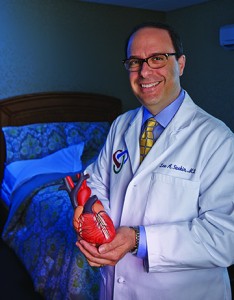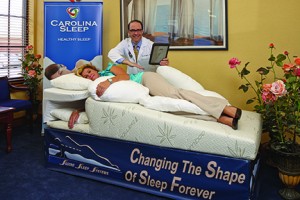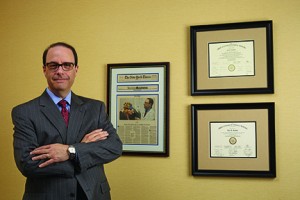Lee A. Surkin, MD, envisions a new communication paradigm between sleep medicine and cardiology.
When Lee A. Surkin, MD, earned his sleep medicine board certification in November 2009, he already had an established cardiology practice. Though he was 
It’s not realistic for sleep physicians to add a cardiology certification. The key, Surkin says, is a greater degree of communication. “We need to work together. Those who are purely sleep physicians and purely cardiologists—which is the majority—need to forge relationships,” Surkin says.
The rewards of a new communication paradigm between sleep medicine and cardiologists are plentiful, he says. In addition to the inherent advantages of forging relationships with colleagues, Surkin says sleep medicine professionals will benefit from an influx of referrals from cardiologists. The greater identified patient population would likely then spearhead clinical and research opportunities. Of course, most importantly, better communication should result in enhanced care and better outcomes for individual patients.
Surkin’s vision:

The staff at Carolina Sleep recognizes the connections between sleep, the cardiovascular system, and obesity.
The link between obstructive sleep apnea (OSA) and cardiovascular disease is increasing in awareness among researchers and clinicians worldwide. Evidence has established that sleep apnea is associated with hypertension (HTN), atrial fibrillation (AFib), coronary artery disease (CAD), congestive heart failure (CHF), and stroke. According to the widely cited Wisconsin Sleep Cohort Study published in 1993, 4% of middle-aged men and 2% of middle-aged women (ages 30-60 years) have OSA. An update published in 2013 now suggests that the current prevalence estimates of moderate to severe OSA are 10% among 30–49-year-old men; 17% among 50–70-year-old men; 3% among 30–49-year-old women; and 9% among 50–70-year-old women. These estimated prevalence rates represent substantial increases over the last two decades.1 Additional medical research will help navigate this developing and compelling association.
It is important for the sleep physician to recognize and embrace the fact that multiple sleep disorders have a direct adverse affect on the cardiovascular system. At present, the opportunity and role of the physicians in this convergence are ill defined and warrant an evolutionary team approach consisting of sleep physicians and cardiologists working cooperatively to tackle this healthcare crisis.
The purpose of this article is to provide educational information for sleep physicians and raise awareness about the significance of the convergence between sleep disorders and cardiovascular diseases. I hope to stimulate growing interest in the importance of our role in this dynamic relationship.

Surkin stays up to date on both cardiology and sleep journals and hopes one day the AACSM will launch a journal combining the two disciplines.
As a cardiologist early on in my private practice experience, it became apparent that a high percentage of my patients manifested signs and symptoms of sleep apnea. I began referring patients to sleep medicine colleagues for testing and treatment. Months later when these patients returned for follow-up, I noticed they were clinically improved and their cardiovascular disease seemed to be more stable. This prompted me to explore the evidence available at the time linking the two disease entities. I then continued to incorporate sleep medicine to a greater degree in my cardiology practice. While there was not an abundant amount of robust information, there was enough to prompt me to pursue more formal training, additional education, and board certification in sleep medicine.
Association
Over the past couple of decades, clinical and academic research as well as epidemiological population-based studies and trials have clearly established a close association between sleep apnea and cardiovascular diseases of many types. The strongest association involves HTN resulting in the addition of sleep apnea as an identifiable cause in Joint National Committee-7 (JNC-7), which also concludes that CPAP therapy can be an effective treatment of HTN. Additional close associations between cardiovascular disease and sleep apnea include arrhythmias such as AFib, CHF, coronary artery disease/myocardial infarction (CAD/MI), cerebrovascular insult (CVI), and Type II diabetes. If you also consider the increasing prevalence of obesity worldwide, the argument supporting the importance of recognizing sleep apnea and cardiovascular disease being convergent becomes even more compelling. In addition, the risk factors for both disease entities are virtually identical. A presentation at the European Society of Cardiology, 2012 is titled and concludes, “Sleep apnea is a major unrecognized cardiovascular risk factor,”2 with which I would concur.
Statistical facts about sleep apnea also merit the close attention of the cardiovascular disease specialist:
- 50% of OSA patients are hypertensive3
- An estimated 30% of hypertensive patients also have OSA3
- OSA patients have diminished heart rate variability and increased blood pressure variability3
- Nocturnal arrhythmias have been shown to occur in up to 50% of OSA patients3
- 71% of all patients diagnosed with cardiovascular disease have sleep apnea4
- Studies have reported a 53% prevalence of OSA and CHF5
- Obstructive sleep apnea is independently associated with sudden cardiac death, as reported in the August 2013 Journal of the American College of Cardiology.6
There is also a growing body of evidence that other sleep disorders are associated with cardiovascular disease. Insomnia and restless legs syndrome both have data showing an association with HTN, CAD, and/or CHF.7,8 Additional research is under way to establish stronger associations and evaluate outcomes.
Treatment
The impact of sleep apnea treatment on cardiovascular disease is also quite revealing:
- There is a clear body of evidence showing an association between AFib and OSA. In a landmark study in 2004, Gami et al showed that after adjusting for body mass index, neck circumference, HTN, and diabetes mellitus, approximately half of patients with AFib were likely to have OSA (adjusted OR 2.19, 95% CI 1.40–3.42).9 Treating OSA improves AFib recurrence after both cardioversion and ablation.10
- The data from small studies on CPAP and CHF in patients with obstructive and central sleep apnea reveal benefits in morbidity and mortality with improved left ventricular hemodynamics and left ventricular ejection fraction.11,12 There are ongoing large scale studies evaluating both morbidity and mortality in the United States and Europe utilizing more sophisticated PAP devices.
- OSA is associated with an increased risk for CAD.13 Treatment has been shown to improve long-term cardiovascular outcomes.14
- Adherence to CPAP improves glycemic control in patients with OSA and type 2 diabetes.15 CPAP also improves markers of inflammation.16
Conclusions
As we enter a new paradigm of healthcare delivery in a constantly evolving system, we are faced with ever increasing burdens forcing us to balance the needs of our patients with our professional careers. The trend within sleep medicine and cardiology practices has led many to opt for employment in large healthcare institutions and away from traditional private practices. This has resulted in perceived financial stability, which comes at the cost of the employee physician’s need to exercise a greater degree of efficiency with concurrent increased pressure on productivity. When considering this, coupled with the gradual adoption of the Affordable Care Act, hospitals and their physician employees are compelled to address head on the critical problem of inpatient readmissions.
Within cardiology, it is clear that we have made great strides in managing our CHF, arrhythmia, and CAD patients, but readmission rates, especially for CHF and recurrent AFib, remain a significant problem. A major impact can be made on these readmissions through a heightened awareness of the cardio-sleep association. The patient will receive optimal care from the dual specialty cardio-sleep physician team, readmissions and likely even admissions will be reduced, and the physicians will work synergistically rather than independently. Considering this dramatic association, the sleep physician is presented with an interesting opportunity to take a leadership role in identifying patients with possible cardiovascular disease, participate in their diagnosis, and incorporate their cardiology colleagues in the healthcare management team.
I would suggest that our opportunity and obligation as sleep medicine specialists is to become educated in a more thorough manner on cardiovascular disorders and become proactive in forging relationships with the board-certified cardiologists for management. The sleep practitioner should consider obtaining basic cardiac screening tests such as an ECG and focusing on assessing the patient for major cardiac risk factors such as HTN, diabetes, hyperlipidemia, tobacco history, and family history of premature artery disease, obesity, sedentary lifestyle, and stress. Established risk-assessing questionnaires such as the Framingham Risk Score can be very useful tools. In addition, sleep medicine training and continuing medical education programs should place a greater emphasis on educating fellows and established sleep practitioners, respectively, about the associated cardiovascular disorders, testing modalities, and treatment options so it becomes ingrained in their scope of care.
While we clearly need more rigorous clinical and academic data looking at major cardiac endpoints, the evidence from published studies clearly links the two disease processes in a more compelling manner than with any other subspecialty. We are all keenly aware that heart disease is the number-one cause of mortality in men and women. In addition, we need to recognize epidemiologic data suggesting that 70 million people in the United States have sleep disorders, of which 20 to 30 million have OSA. In addition, a recent article published by the CDC concludes that one in four deaths from cardiovascular disease is preventable with healthy lifestyle changes and better management of associated comorbidities of hypertension, diabetes, and obesity.17 Needless to say, all these are linked to OSA.
Physicians who are aware of the relationship between sleep and cardiovascular disease have a unique opportunity to make a major impact on the future of global healthcare. They will be able to enhance quality of life, work with the idea of prevention of major diseases, and halt the progression of preexisting diseases. The scope of the cardio-sleep relationship is broad and its depths need to be discovered further. Clinical and academic researchers will brave the existing medical community and search for additional life-changing discoveries that link sleep and cardiovascular disease to establish definitive outcomes data and refine practice guidelines. This research must be cultivated and generously supported.
The recognition of the converging specialties of sleep medicine and cardiology is already in place but more dedicated research is required. We simply see the very tip of the iceberg—but it has given us enough vision to know we need to dive deeper to learn more about the connection and, most importantly, to learn how we can utilize the findings to provide efficient, cost-effective, and optimal patient care. We will then truly get to the heart of sleep.
Lee A. Surkin, MD, FACC, FASNC, FCCP, is triple board certified in sleep medicine, cardiovascular disease, and nuclear cardiology. He is the founder of the American Academy of Cardiovascular Sleep Medicine (AACSM), which is an organization dedicated to supporting research, promoting awareness, and providing education about the convergence of sleep disorders and cardiovascular disease. His private practice in Greenville, NC, uniquely combines sleep medicine, cardiovascular disease, and obesity medicine. CONTACT [email protected]
REFERENCES
1. Peppard P, Young T, Barnet J, Palta M, Hagen E, Hla KM. Increased prevalence of sleep-disordered breathing in adults. Am J Epidemiol. 2013;177:1006-14. doi: 10.1093/aje/kws342
2. Costas Tsioufis (P. Penteli, Athens, Greece). Sleep apnea is a major unrecognised cardiovascular risk factor. Oral Presentation at ESC Congress, 2012.
3. Somers VK, White DP, Amin R, et al. Sleep apnea and cardiovascular disease: an American Heart Association/American College of Cardiology Foundation Scientific Statement from the American Heart Association Council for High Blood Pressure Research Professional Education Committee, Council on Clinical Cardiology, Stroke Council, and Council on Cardiovascular Nursing. In collaboration with the National Heart, Lung, and Blood Institute National Center on Sleep Disorders Research (National Institutes of Health). Circulation. 2008;118:1080-1111.
4. Floras JS. Sleep apnea in heart failure: implications of sympathetic nervous system activation for disease progression and treatment. Curr Heart Fail Rep. 2005;2(4):212-217.
5. Wang H, Parker JD, Newton GE, et al. Sleep apnea and mortality in heart failure. J Am Coll Cardiol. 2007;49:1625–31.
6. Gami AS, Olson EJ, Shen WK, et al. Obstructive sleep apnea and the risk of sudden cardiac death: a longitudinal study of 10,701 adults. J Am Coll Cardiol. 2013;62:610-616.
7. Laugsand LE, Strand LB, Platou C, Vatten LJ, Janszky I. Insomnia and the risk of incident heart failure: a population study. Eur Heart J. 2013;35:1382-93.
8. Winkleman JW, Shahar E, Sharief I, Gottlieb DH. Association of restless legs syndrome and cardiovascular disease in the Sleep Heart Health Study. Neurology. 2008;70(1):35-42.
9. Gami AS, Pressman G, Caples SM, et al. Association of atrial fibrillation and obstructive sleep apnea. Circulation. 2004;110:364–367.
10. Anter E, Zimetbaum P, Josephson M, Treatment of obstructive sleep apnea reduces the risk of atrial fibrillation recurrence following catheter ablation. J Am Coll Cardiol. 2012;5(13, suppl 1):E612.
11. Javaheri S, Caref B, Chen E, Tong KB, Abraham WT. Sleep apnea testing and outcomes in a large cohort of Medicare beneficiaries with newly diagnosed heart failure. Am J Respir Crit Care Med. 2011;183:539-546.
12. Arzt M, Floras JS, Logan AG, et al. Suppression of central sleep apnea by continuous positive airway pressure and transplant-free survival in heart failure. Circulation. 2007;115:3173-3180.
13. Sorajja D, Gami AS, Somers VK, Behrenbeck TR, Garcia-Touchard A, Lopez-Jimenez F. Independent association between obstructive sleep apnea and subclinical coronary artery disease. Chest. 2008;133:927-933.
14. Marin JM, Carrizo S, Vicente E, Agusti AG. Long-term cardiovascular outcomes in men with obstructive sleep apnoea-hypopnoea with or without treatment with continuous positive airway pressure: an observational study. Lancet. 2005;365:1046-1053.
15. Tasali E, Abraham V, Arohnson R, et al. Effective CPAP treatment of obstructive sleep apnea improves glycemic control in type 2 diabetics. Sleep 2013; June 1-5, 2013; Baltimore. Abstract 0344.
16. Baessler A, Nadeem R, Harvey M, et al. Treatment for sleep apnea by continuous positive airway pressure improves levels of inflammatory markers. J Inflamm (Lond). 2013;10:13.
17. http://www.cdc.gov/vitalsigns/HeartDisease-Stroke






